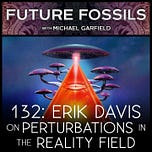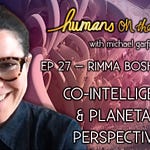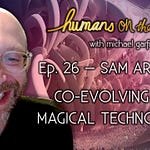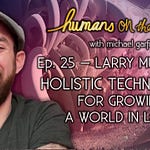This week’s guest is author, culture critic, and philosopher of the weird Erik Davis, whose work has been one of my main inspirations for almost ten years. His latest work of epic scholarship, High Weirdness: Drugs, Esoterica, and Visionary Experience in the Seventies, is an exploration of topics I presumed inaccessible to academic inquiry so masterful I’ve been evangelizing it for months and basically forced a copy on my boss (David Krakauer, President of the Santa Fe Institute, who was a guest in Episode 75). In this episode we peer into the intersection of psychedelics, madness, systems science, postmodernism, and religious studies to ask about the truly other that refuses to allow us a clean answer to the questions, “What is the Real?” and “Did that just really happen?” Strap in for one of the headiest and most important conversations that we’ve ever had on Future Fossils…
Join the Future Fossils Podcast Patreon for exclusive perks like an extra 10 minutes of this conversation, in which Erik & Michael discuss “black goo.”
Visit Erik’s website to sign up for his email updates (always wonderful) and stay abreast of upcoming events, such as his talk at the SF Psychedelic Society on Thursday Dec 19.
Get a copy of High Weirdness at MIT Press.
Erik’s appearance on Future Fossils Episode 99 (a kind of prequel to this conversation).
My 2011 and 2012 appearances on Erik’s podcast, Expanding Mind.
Erik and I discuss over video chat (part 1, part 2) the revised and expanded third edition of his book Techgnosis: Myth, Magic, and Mysticism in the Age of Information.
Shop through my Amazon storefront and support the show indirectly with your purchases:
https://amazon.com/storefront/michaelgarfield
Join the Future Fossils Facebook Discussion Group
https://facebook.com/groups/futurefossils
Show music by Evan “Skytree” Snyder feat. Michael Garfield, “God Detector”
https://skytree.bandcamp.com/track/god-detector-ft-michael-garfield
Mentioned:
Jacques Lacan. Mark Fisher. Carol Cusack. Eric Wargo. Timothy Morton. Graham Harman. Jeff Kripal. Emelie Gomar. Bruno Latour. Albert Hofmann. Sasha Shulgin. Richard Doyle. Williiam James. Phil Dick. Cesar Hidalgo. Rachel Armstrong. Edward Snowden. Daniel Paul Schraber.
We Discuss:
The abyss is close to home.
“The real, by definition, is not amenable to symbolization. Whatever kind of yen we have to sustain the symbolic in the face of the real is going to fail. And in that sense, the real is fundamentally traumatic.”
Perturbations of the reality field.
Extimacy.
“That’s not me…or if it is, I’m not me anymore.”
Refusing to remain within the purely human. To lean out. To open a portal.
The Weird vs. The Uncanny.
Fiction vs. Religion.
“In some sense Burning Man and the spirituality of Burning Man, if you want to call it that – the invention of new subjectivities, the development of an ecstatic culture at this end stage of capitalism and modern mythology – in a way is a kind of later iteration of the things I saw in the 70s.”
Material agency in the practice of science. “Science is not practiced by humans alone.” “Drugs as active participants in the enactment of their effects.”
“The thing about thinking is that sometimes it’s really clear the way you are actively putting things together, or actively exploring. But then sometimes it seems as if you are almost kind of taken over by an idea, and then the idea has stuff it wants to do, and you are just the connector or vehicle for it. What it means to think is to be in relationship to enigmas that have things to say.”
“With reductionism in general, it’s very difficult to explain novelty.”
“A psychedelic compound sitting on the shelf is not psychedelic. It’s in the interaction that you explore and discover its phenomenological features.”
“There’s no way out of environmental effects in the psychedelic experience - both in the set and setting, and in terms of whatever mysterious multiplicities lie in the material itself. So there’s no way to do capital S Science with psychedelics, despite the fact that they are material molecules that reliably have a certain kind of metabolic arc and can be explained in terms of how they are broken down in the body and even light up certain regions or the brain, etc., etc. I think it’s kind of wonderful. But I think that’s where the weird is: the weird is in that. The weird is in the way you can’t get out of the loop.”
Psychogenic Networks and Maximal Entropy Production.
“If attention is the fuel, then everywhere we turn, we’re producing self-fulfilling prophecies.”
Living Fictions.
Weird Studies Episode 36.
Lachmann et al. 1999 re: Optimal Encoding & Fermi’s Paradox & “The symbols of the divine first emerge in the trash stratum.”
“The revelation is always relativized. Once we’re in this cybernetic situation, then not only do we not know, ‘Is that noise or is that signal?,’ but even when you do get a message, you don’t get to know. Because you’ve knocked out that realm of certainty that in the past said, ‘What you’re thinking is true.’”
“Now we get to see what it looks like when the symbolic order, consensus reality, breaks down, melts, mutiplies, becomes weaponized, and we try to make our way through that. And it’s not so fun. It’s not so pretty. It’s not so groovy.”
Psychonautics as preparation for the insane world we now live in, where the weird has mainstreamed.
Support this show http://supporter.acast.com/futurefossils.
Hosted on Acast. See acast.com/privacy for more information.










